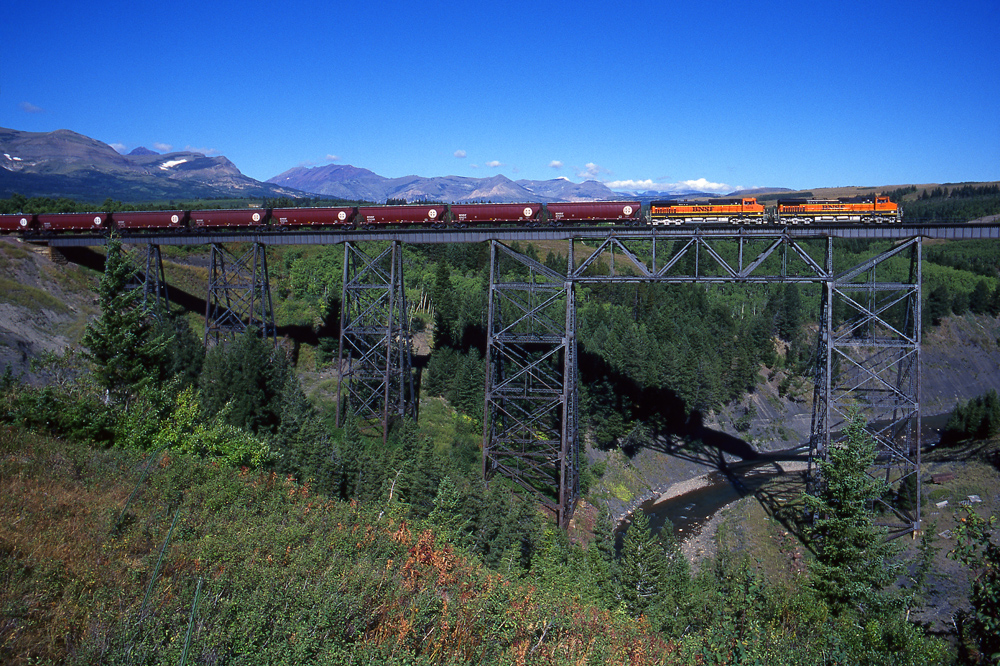
WASHINGTON — BNSF Railway has told federal regulators that it’s prepared for the upcoming fall grain harvest, but defended its performance last year amid weather-related disruptions to the broader supply chain.
Surface Transportation Board Chairman Robert E. Primus requested the update from BNSF, which he said had struggled to handle the fall harvest in recent years. “I, along with many of your agricultural stakeholders, continue to have grave concerns about BNSF’s ability to adequately serve the anticipated demand, particularly that moving through the Pacific Northwest (PNW) corridor,” Primus wrote in a July 23 letter to BNSF CEO Katie Farmer.
BNSF has adequate crews, locomotives, and capacity to handle the seasonal surge in grain traffic, Farmer wrote in an Aug. 8 letter posted to the STB website on Aug. 9. But Farmer told Primus, “I respectfully disagree with your characterization that BNSF struggled to live up to our responsibilities during last year’s harvest.”
BNSF pre-positioned grain shuttle trains, as usual, but heavy rains delayed the harvest and prompted the railroad to hold empty trains at origin. This delay created an overlap in grain train loading schedules, so trains that had been held and trains with current reservations had to compete for crews.
In December, heavy rains hit the Pacific Northwest, which forced some export terminals to stop loading vessels. This prompted BNSF to stage loaded trains across the Northern Transcon.
“While BNSF has invested billions of dollars into our network to build resiliency in the face of weather-related challenges, externalities outside of our control and our customers’ control can and do affect the ability to load and operate trains,” Farmer wrote. “The cascading effects of these disruptions are an example of the unavoidable variability in any freight transportation service but should not be equated to service failure.”
BNSF grain exports via the Pacific Northwest increased 18% vs. prior season. BNSF grain-shuttle cycle time averaged 2.6 turns per month in September, October, and November last year, with a low of 2.2 in October and a high of 2.9 in September.
For the first half of 2024, agricultural products volumes on BNSF are up 11%. The demand outlook is uncertain this fall considering unusually low corn and soybean export sales for this time of year, BNSF said. Nonetheless, BNSF is preparing to handle similar grain volumes to last year as part of its fourth-quarter demand forecast.
Primus also had requested information regarding service to and from Mexico, which is a major importer of U.S. grain. Ferromex has been experiencing bouts of congestion since late last year. “We can ill afford to again have BNSF lose access to more than 120 locomotives and have grain shipments embargoed and delayed during this year’s fall harvest,” Primus wrote.
A coalition of agricultural groups last month told the STB that FXE’s capacity has not kept pace with growth in cross-border rail traffic, and that while migrant surges affected the railroad’s service, the main problem has been lack of capacity.
Farmer said she shared the STB’s concerns about disruptions to cross-border service. “Service to Mexico has been undeniably challenged this year, largely due to the impacts of the ongoing humanitarian crisis at the southern border,” she wrote. “Indeed, our access to Mexico at certain interchanges has been closed on three different occasions over the past nine months, once due to an order from the Department of Homeland Security and twice due to Ferromex (FXE) embargoes.”
The limited windows for interchange at the border crossings at El Paso and Eagle Pass, Texas, contribute to delays in clearing backlogs of all traffic, she wrote.
BNSF has worked with FXE to improve the flow of traffic. Efforts include daily conference calls, staging southbound traffic to take advantage of interchange windows at the border, and using permits and embargoes to manage volumes.
“For example, in late June we agreed to forego any southbound interchange for 48 hours to facilitate increased FXE northbound interchange to clear some of the congestion off its system,” Farmer wrote.
BNSF handles more agricultural products shipments than any other U.S. railroad. Over the past decade, ag products shipments are up by 120,000 loads on BNSF, while the three other U.S. Class I systems have seen their ag products volume decline by a combined 200,000 carloads, Farmer wrote.














Look for trucks to start dumping Canadian grain over the border at US grain terminals. UP and BNSF should expect more grain if the CN and CPKC strike holds up north of the border.
Well as soon as they get the grain cleaned up from the Iowa derailment.